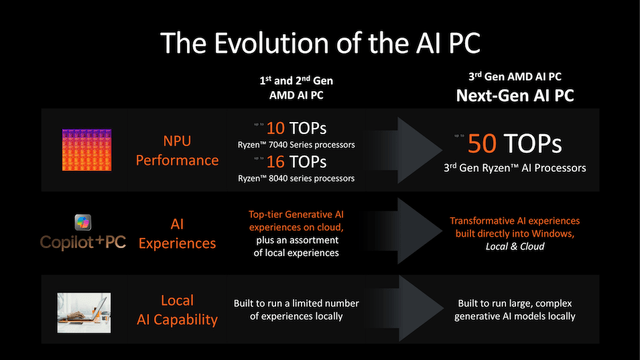AMD Responds Forcefully To Nvidia Hype With A Strong Computex Showing
Advanced Micro Devices (AMD) had one of the strongest Computex showings ever with a keynote from CEO Lisa Su covering a wide spectrum of issues including the important Data Center GPU Accelerator roadmap.
Zen 5 Delivers Strong Performance
The highlight of the presentation was widely expected to be the Company’s new Zen5 core. The leaks on the new CPU core have been divergent with competitive intelligence suggesting that the chips based on the Zen 5 core were delivering 30%, 40%, 50%, or even higher performance at a socket level while some other claims suggesting little to no gains to over 40% gains at IPC (instructions per clock) level.
As such there are several key factors that dictate generational performance advantage at the chip level – core IPC enhancements, increase in CPU core count, frequency enhancements, power enhancements, and increase in thermal power envelope. In addition to these, companies routinely choose to enhance a particular type of performance compared to others (ex: focus on integer vs floating point vs streaming throughput). Given such variations, it is not uncommon to have diverse estimates of new CPU performance. However, even considering these, Zen5 rumors suggested a very wide spread of performance gains.
Lower Than Rumored IPC Is Not A Negative It Appears
One of the primary benefits of using an advanced process is that the design can cram in more gates at lower power and thus use the overall thermal budget to deliver a higher performance. While AMD’s disclosures on Zen 5 core itself were sparse, a quick look at the client CPU architecture shows how AMD chose to enhance some aspects more than the others (see image below).
For the client, AMD focused not on adding integer cores but instead considerably beefing up the NPU and GPU. What this means is that AMD’s primary focus for the client was AI and gaming performance. The results can be seen from the image below: A huge jump in AI performance from 16 TOPs to 50 TOPs.
AMD is releasing only two products using this design under the AI 300 series – AI 9 HX 370 and AI 9 365. While specs are slightly different, investors can rest assured that both chips are derived from the same piece of silicon and AMD is cherry picking the best chips out of the fab and binning them as AI9 HX 370. And those chips that do not quite meet the bins because of lower operating frequencies or a failed CPU core (or two) will be binned as AI9 365.
Given the AI focus, AMD expects these chips to convincingly beat Intel (INTC) and Qualcomm (QCOM) alternative offerings in AI performance (image below).
And it is not just the raw TOPs number, but AMD implied/claimed that AMD’s AI hardware approach is superior to Qualcomm’s (image below).
AMD presented some competitive data against ARM performance. Beyond The Hype did not verify how AMD got the underlying data as AMD’s benchmark claims typically tend to be in the right ballpark. If AMD’s claims are true, as they likely are, the Qualcomm ARM offering is looking quite shaky before it is even launched.
The inferior AI performance effectively kills one of the two largest benefits that Qualcomm was touting with its ARM offerings. With this setback, all that is left for Qualcomm to fall back is the highly dubious claim about ARM’s power advantage over x86. Qualcomm will continue to claim superior power performance but only time will tell if that stand to scrutiny. Beyond The Hype continues to be skeptical about ARM proponents claims in this regard. ARM may offer slight benefit all things being equal, but all things are rarely equal, and AMD is likely to be at an advantage in this regard.
Keep reading with a 7-day free trial
Subscribe to Beyond The Hype - Looking Past Management & Wall Street Hype to keep reading this post and get 7 days of free access to the full post archives.








